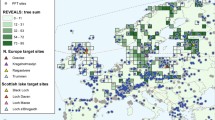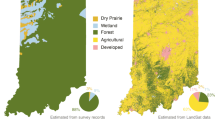Abstract
Predicted atmospheric change, mainly climate change, will have profound effects on the biodiversity of Canadian forests. Predictions derived from forest models, responses of species and ecosystems related to modern ecological characteristics and paleoecological studies suggest large-scale, wide-ranging changes from the biome to physiological levels. Paleoecological analogues in B.C. and other parts of Canada reveal that major changes must be expected in forest composition, range, structure and ecological processes. In B.C., past warmer and drier climates supported a different forest pattern, including forest types with no modern analogue. This produced dramatically different disturbance regimes, specifically more fires, and affected tree growth rates. The relationship of forests with non-forest habitats, especially wetlands and grasslands was different suggesting implications for wildlife biodiversity. British Columbia's Forest Practices Code prescribes guidelines for biodiversity objectives but ignores the issue of atmospheric change. This omission may result from a lack of understanding of the profound potential effects of atmospheric change on forest biodiversity in the next harvest cycle and lack of mechanisms to assess impacts and develop management strategies for specific sites. An example of a simple paleoecological assessment method involving pollen ratios is proposed.
Similar content being viewed by others
References
Allen, G. B.: 1995, Vegetation and Climate History of Southeast Vancouver Island, British Columbia, M.Sc. Thesis. School of Earth and Ocean Sciences, University of Victoria, Victoria.
Banner, A., Pojar, J. and Rouse, G. E.: 1983, Postglacial paleoecology and successional relationships of bog woodland near Prince Rupert, British Columbia, Canadian Journal of Forest Research 13, 938.
Berglund, B. E.: 1986, Handbook of Holocene Palaeoecology and Palaeohydrology, John Wiley & Sons, New York.
Brubaker, L.: 1992, Climate Change and the Origin of Old-Growth Douglas-Fir Forests in the Puget Sound Lowland, in: G. E. Wall (ed.), Implications of Climate Change for Pacific Northwest Forest Management, University of Waterloo, Department of Geography Occasional Paper No. 15. Waterloo, Ontario, pp. 5–18.
Burton, P. J. and Cumming, S. G.: 1995, Potential effects of climate change on some western Canadian forests based on phenological enhancements to a patch model of forest succession, Water, Air, and Soil Pollut. 82, 401.
Cwynar, L. C.: 1987, Fire and the forest history of the North Cascade Range, Ecology 68, 791.
Davis, M. B.: 1981, Quaternary History and the Stability of Forest Communities, in: D. C. West, H. H. Shugart and D. B. Botkin (eds.), Forest succession: Concepts and Application, Chapter 10. Springer-Verlag, New York.
Emanuel, W. R., Shugart, H. H. and M. P. Stevenson: 1985, Climatic change and the broad-scale distribution of terrestrial ecosystem complexes, Climatic Change 7, 29.
Fritts, H. C.: 1976, Tree Rings and Climate, Academic Press, New York.
Harrington, J., Kimmins, J., Lavender, D. and Zoltai, S.: 1991, The Effect of Climate Change on Forest Ecology of Canada, in: Proceedings of the 10thWorld Forestry Congress, Paris, September 1991.
Hebda, R. J.: 1982, Postglacial History of Grasslands of Southern British Columbia and Adjacent Regions, in: A. C. Nicholson, A. McLean, and T. E. Baker (eds.), Grassland Ecology and Classification Symposium Proceedings, British Columbia Ministry of Forests, Victoria, British Columbia. pp. 157–191.
Hebda, R. J.: 1994, The Future of British Columbia's Flora, in: Harding, L. E. and E. McCullum (eds.), Biodiversity in British Columbia: Our Changing Environment, Canadian Wildlife Service, Environment Canada, Vancouver, B.C. pp. 343–352.
Hebda, R. J.: 1995, British Columbia vegetation and climate history with focus on 6 KA BP, Géographie Physique et Quaternaire 49, 55.
Hebda, R. J.: 1997, Impact of Climate Change on Biogeoclimatic Zones of British Columbia and Yukon, in: E. Taylor and B. Taylor (ed.), Future Climate Change in British Columbia and Yukon, Environment Canada and Ministry of Environment, Lands, and Parks, Province of British Columbia, Victoria, B.C., pp. 13: 1–15.
Hebda, R. J. and Mathewes, R. W.: 1984, Holocene history of cedar and native cultures of the North American Pacific Coast, Science 25, 711.
Hebda, R. J. and Whitlock, C.: 1997, Environmental History of the Coastal Temperate Rain Forest of Northwest North America, in: Schoonmaker, P. K., von Hagen, B. and E. C. Wolf. (eds.), The Rain Forests of home: Profile of a North American Bioregion. Island Press, Covelo, CA, pp. 227–354.
Jetté, H.: 1997, A Canadian contribution to the Paleoclimate Model Intercomparison Project (PMIP), Géographie Physique et Quaternaire 49, 4.
Laroque, C. P.: 1995, The Dendrochronology and Dendroclimatology of Yellow Cedar on Vancouver Island, British Columbia, M.Sc. Thesis, Geography Department, University of Victoria, Victoria. 104 p.
Lenihan, J. M. and Neilson, R. P.: 1995, Canadian vegetation sensitivity to projected climatic change at three organizational levels, Climate Change 30, 27.
Leverenz, J. W. and Lev, D. J.: 1987, Effects of Carbon Dioxide-Induced Climate Changes on the Natural Range of Six Major Commercial Tree Species in the Western United States, in: W. E. Shands and J. S. Hoffman (eds.), The Greenhouse Effect, Climate Change and U.S. Forests, Washington D.C. The conservation Foundation, pp 123–155.
Mathewes, R.W. and Rouse G. E.: 1975, Palynology and paleoecology of early postglacial sediments from the lower Fraser River Canyon of British Columbia, Canadian Journal of Earth Sciences 12, 745.
Meidinger, D. and Pojar, J. (eds.): 1991, Ecosystems of British Columbia, Research Branch, Ministry of Forests, Province of British Columbia. Victoria, B.C.
Melillo, J. M., Callaghan, T. V., Woodward, F. I., Salati, E. and S. K. Sinha: 1990, Effects on Ecosystems, in: J. T. Houghton, G. J. Jenkins and J. J. Ephraums (eds.), Climate Change: The IPCC Scientific Assessment, Cambridge University Press, pp. 283–310.
Ministry of Forests and B.C. Environment: 1995, Biodiversity Guidebook, Forest Practices Code of British Columbia (Series). British Columbia Ministry of Forests and B.C. Environment, Victoria, B.C.
Moore, P. D., Webb, J. A. and Collinson, M. E.: 1991, Pollen Analysis: second edition, Blackwell Scientific Publications, Oxford.
Munn, R. E. (ed.), 1996, Atmospheric Change and Biodiversity: Formulating a Canadian science agenda, Institute for Environmental Studies, University of Toronto, Toronto.
Nagorsen, D.W. and Keddie, G. and Luszcz, T.: 1996, Vancouver Island marmot bones from subalpine caves: archaeological and biological significance, Occasional Paper No. 4, B.C. Parks, Victoria, B.C. 56 p.
Ogilvie, R. T., Hebda, R. J. and Roemer, H. L.: 1984, Phytogeography of Oxalis oregana Nutt. in British Columbia, Canadian Journal of Botany 62, 1561.
Pellatt, M. G. and Mathewes, R. W.: 1994, Paleoecology of postglacial treeline fluctuations on the Queen Charlotte Islands, Canada, Ecoscience 1, 71.
Peteet, D. M.: 1986, Modern pollen rain and vegetational history of the Malaspina Glacier District, Alaska, Quaternary Research 25, 100.
Peteet, D. M., Daniels, R. A., Heusser, L. E., Vogel, J. S., Southon, J. R. and Nelson, D. E.: 1993, Late-glacial pollen, macrofossil and fish remains in northeastern U.S.A.– The Younger Dryas oscillation, Quaternary Science Reviews 12, 597.
Pollard, D. F.W.: 1992, The Role of Natural Areas in a Changing Climate, in: G. E. Wall (ed.), Implications of Climate Change for Pacific Northwest Forest Management, University of Waterloo, Department of Geography Occasional Paper No. 15. Waterloo, Ontario, pp. 175–183.
Ritchie, J. C.: 1987, Postglacial Vegetation of Canada, Cambridge University Press, Cambridge, 178 p.
Rizzo, B. and Wiken, E.: 1992, Assessing sensitivity of Canada's ecosystems to climatic change, Climatic Change 21, 37.
Solomon, A. M.: 1986, Transient response of forests to CO2-induced climate change: Simulation modelling experiments in eastern North America, Oecologia 68, 567.
Spittlehouse, D. L.: 1996, Assessing and Responding to the Effects of Climate Change on Forest Ecosystems, in: R. G. Lawford, P. B. Alaback and E. Fuentes (eds.), High-latitude Rainforests and Associated Ecosystems of the West Coast of the Americas, Springer-Verlag, New York. pp. 306–319.
Spittlehouse, D. L. and Childs, S. W.: 1990, Evaluating the Seedling Moisture Environment After Site Preparation, in: S. P. Gessel, D. S. Lacate, G. F. Weetman and R. F. Powers (eds.), Sustained Productivity of Forest Soils, Proceedings of the Seventh North American Soils Conference. Vancouver: University of British Columbia, Faculty of Forestry Publication. pp. 80–94.
Suffling, R.: 1995, Can disturbance determine vegetation distribution during climate warming? A boreal test, J. Biogeography 22, 501.
Vance, R. E., Beaudoin, A. B. and Luckman, B. H.: 1995, The paleoecological record of 6 ka BP climate in the Canadian prairie provinces, Géographie Physique et Quaternaire 49, 81.
Wainman, N. and Mathewes, R. W.: 1986, Forest History of the last 12 000 yr based on plant macrofossil analysis of sediment from Marion Lake, southwestern British Columbia, Canadian Journal of Botany 65, 2179.
Whitlock, C.: 1992, Vegetational and climatic history of the Pacific Northwest during the last 20 000 yr: Implications for understanding present-day biodiversity, The Northwest Environmental Journal 8, 5.
Zhang, Q.: 1996, A 2122-Year Tree-ring chronology of Douglas-fir and Precipitation Reconstruction at Heal Lake, Southern Vancouver Island, British Columbia, M.Sc. Thesis, School of Earth and Ocean Sciences, University of Victoria, Victoria.
Author information
Authors and Affiliations
Rights and permissions
About this article
Cite this article
Hebda, R. Atmospheric Change, Forests and Biodiversity. Environ Monit Assess 49, 195–212 (1998). https://doi.org/10.1023/A:1005869808440
Issue Date:
DOI: https://doi.org/10.1023/A:1005869808440




